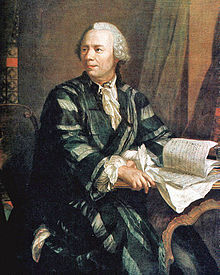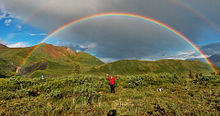Carl Benjamin Boyer
Appearance
(Redirected from Carl B. Boyer)

Carl Benjamin Boyer (November 3, 1906 – April 26, 1976) was an American historian of sciences, and especially mathematics. He wrote the books History of Analytic Geometry, The History of the Calculus and Its Conceptual Development, A History of Mathematics, and The Rainbow: From Myth to Mathematics. He served as book-review editor of Scripta Mathematica.
Quotes
[edit]
- The Introductio does not boast an impressive number of editions, yet its influence was pervasive. In originality and in the richness of its scope it ranks among the greatest of textbooks; but it is outstanding also for clarity of exposition. Published two hundred and two years ago, it nevertheless possesses a remarkable modernity of terminology and notation, as well as of viewpoint. Imitation is indeed the sincerest form of flattery.
- On the work of Leonhard Euler, in "The Foremost Textbook of Modern Times" (1950)
- But what, after all, are the integers? Everyone thinks that he or she knows, for example, what the number three is — until he or she tries to define or explain it.
- As quoted in Everything and More: A Compact History of Infinity (2013) by David Foster Wallace, p. 8
The Rainbow: From Myth to Mathematics (1959)
[edit]
- A Hebrew belief asserted that if Yahweh lays aside his bow and hangs it in the clouds, this is a sign that his anger has subsided. Other peoples have had similar ideas, based upon the tradition that an archer carries his bow with the ends pointing downward when he wishes to indicate his peaceful intentions.
- p. 27
- In ancient classical literature the rainbow sometimes was deified as Iris; at other times it was regarded merely as the route traversed by the messenger of Hera. The conception of the rainbow as a pathway or bridge has been widespread. For some it has been the best of all bridges, built out of three colors; for others the phrase "building on the rainbow" has meant a bootless enterprise. North American Indians were among those who thought of the rainbow as the Pathway of Souls, an interpretation found in many other places. Among the Japanese the rainbow is identified as the "Floating Bridge of Heaven"; and Hawaiian and Polynesian myths allude to the bow as the path to the upper world. In the Austrian Alps the souls of the righteous are said to ascend the bow to heaven; and in New Zealand the dead chieftains are believed to pass along it to reach their new home. In parts of France the rainbow is called the pont du St. Esprit, and in many places it is the bridge of St. Bernard or of St. Martin or of St. Peter. Basque pilgrims knew it as the 'puente de Roma'. Sometimes it is called instead the Croy de St. Denis (or of St. Leonard or of St. Bernard or of St. Martin). In Italy the name arcu de Santa Marina is relatively familiar. Associations of the rainbow and the milky way are frequent. The Arabic name for the milky way is equivalent to Gate of Heaven, and in Russia the analogous role was played by the rainbow. Elsewhere also the bow has been called the Gate of Paradise; and by some the rainbow has been thought to be a ray of light which falls on the earth when Peter opens the heavenly gate. In parts of France the rainbow is known as the porte de St. Jacques, while the milky way is called chemin de St. Jacques. In Swabia and Bavaria saints pass by the rainbow from heaven to earth; while in Polynesia this is the route of the gods themselves.
In Eddic literature the bow served as a link between the gods and man — the Bifrost bridge, guarded by Heimdel, over which the gods passed daily. At the time of the Gotterdamerung the sons of Muspell will cross the bridge and then demolish it. Sometimes also in the Eddas the rainbow is interpreted as a necklace worn by Freyja, the "necklace of the Brisings," alluded to in Beowulf; again it is the bow of Thor from which he shoots arrows at evil spirits. Among the Finns it has been an arc which hurls arrows of fire, in Mozambique it is the arm of a conquering god. In the Japanese Ko-Ji-Ki (or Records of Ancient Matters), compiled presumably in 712, the creation of the island of Onogoro is related to the rainbow. Deities, standing upon the "floating bridge of heaven," thrust down a jeweled spear into the brine and stirred with it. When the spear was withdrawn, the brine that dripped down from the end was piled up in the form of the island. In myth and legend the rainbow has been regarded variously as a harbinger of misfortune and as a sign of good luck. Some have held it to be a bad sign if the feet of the bow rest on water, whereas a rainbow arching from dry land to dry land is a good augury. Dreambooks held that when one dreams of seeing a rainbow, he will give or receive a gift according as the bow is seen in the west or the east. The Crown-prince Frederick August took it as a good omen when, upon his receiving the kingdom form Napoleon in 1806, a rainbow appeared; but others interpreted it as boding ill, a view confirmed by the war and destruction of Saxony which ensued. By many, a rainbow appearing at the birth of a child is taken to be a favorable sign; but in Slavonic accounts a glance from the fay who sits at the foot of the rainbow, combing herself, brings death.- p. 27
- Ptolemy left in his Optics, the earliest surviving table of angles of refraction from air to water. … This table, quoted and requoted until modern times, has been admired … A closer glance at it, however, suggests that there was less experimentation involved in it than originally was thought, for the values of the angles of refraction form an arithmetic progression of second order … As in other portions of Greek Science, confidence in mathematics was here greater than that in the evidence of the senses, although the value corresponding to 60° agrees remarkably well with experience.
- p. 61
- Robert Grosseteste … was born at the decisive moment when Greek and Arabic science became accessible in Latin versions.
- p. 88
- Robert [Grosseteste] became much interested in science and scientific method … He was conscious of the dual approach by means of induction and deduction (resolution and composition); i.e., from the empirical knowledge one proceeds to probable general principles, and from these as premises one them derives conclusions which constitute verifications or falsifications of the principles. This approach to science was not that far removed from Aristotle ...
- p. 88
- Descartes maintained his confidence in the instantaneity of light. … Yet in his derivation of the law of refraction, Descartes reasoned that light travelled faster in a dense medium than in one less dense. He seems to have had no qualms about comparing infinite magnitudes!
- p. 204
- Fermat had recourse to the principle of the economy of nature. Heron and Olympiodorus had pointed out in antiquity that, in reflection, light followed the shortest possible path, thus accounting for the equality of angles. During the medieval period Alhazen and Grosseteste had suggested that in refraction some such principle was also operating, but they could not discover the law. Fermat, however, not only knew (through Descartes) the law of refraction, but he also invented a procedure—equivalent to the differential calculus—for maximizing and minimizing a function of a single variable. … Fermat applied his method … and discovered, to his delight, that the result led to precisely the law which Descartes had enunciated. But although the law is the same, it will be noted that the hypothesis contradicts that of Descartes. Fermat assumed that the speed of light in water to be less than that in air; Descartes' explanation implied the opposite.
- p. 205
Quotes about Boyer
[edit]- Carl B. Boyer … is more or less the Gibbon of math history.
- David Foster Wallace (2013), Everything and More: A Compact History of Infinity. p. 8

